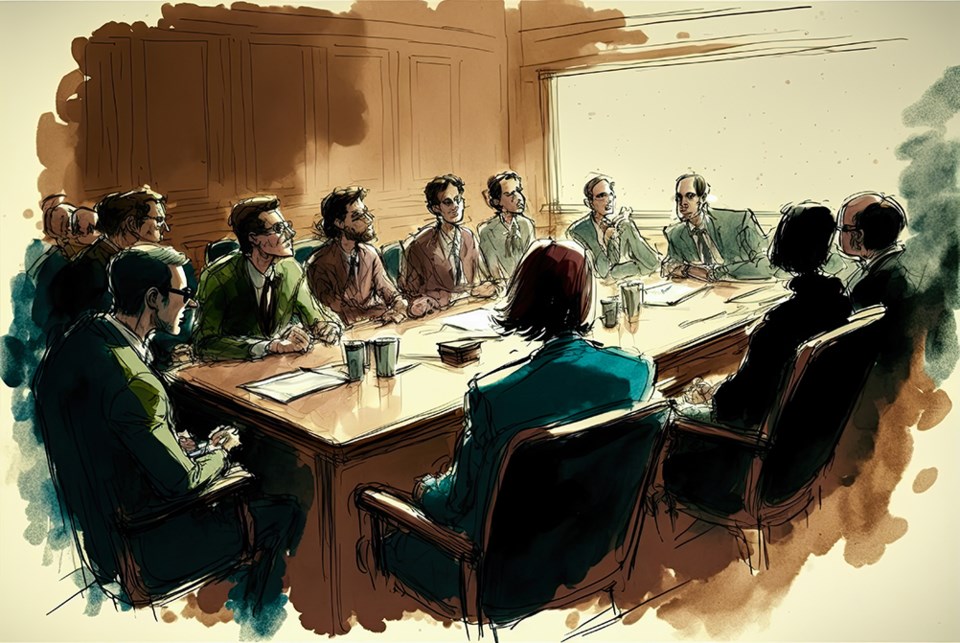Nervous laughter resonated throughout one of the courtrooms of the Arlington County Justice Center Oct. 9 – from a group of seen-it-all attorneys, no less.
The reason? They were having the rare chance to listen in – eavesdrop, as it were – during jury deliberations.
It wasn’t a real legal case, of course, rather part of the Professor Michael L. Davis Reality Trial, an annual-except-during-COVID initiative of the Arlington County Bar Association and Arlington Bar Foundation. The program aims to serve, as best possible, as an eye-opener for practicing attorneys to learn what REALLY goes on during jury deliberations.
“An incredible exercise, it really is – an incredible education experience for practicing attorneys,” said Circuit Court Judge Daniel Fiore II, who presided over the day-long event (held during a state holiday to not interfere with actual legal proceedings).
The case in question was civil in nature. Under the scenario presented, a bicyclist been forced to move out of the bicycle lane on Clarendon Boulevard in order to avoid an illegally parked vehicle. The bicyclist then hit a moving car and was knocked to the ground, suffering serious injuries. (Remember: While certainly plausible, the incident never occurred; it simply was the basis for the mock trial.)
The victim sued the driver of the illegally parked vehicle, seeking a little more than $800,000 in overall damages.
The jury of four men and three women heard both sides present their case and listened to witnesses give testimony, then retired for deliberations knowing that the cameras would be on them and a room-full of attorneys, law students and one media representative would be watching them. In their hands were 27 separate jury instructions given to them by the judge, designed to guide their conversations.
Based on the discussions held in the jury room, the bicyclist almost assuredly would have collected at least some of what was being sought, except for a quirk in Virginia law.
Unlike all but a handful of other states, the Old Dominion’s statute requires that, if the plaintiff is even a small amount at fault in such a case, he or she can’t be awarded monetary damages.
“Most states have ‘comparative negligence.’ Our law is strictly ‘contributory negligence,’” said Michael Davis, a senior lecturer in law at the Antonin Scalia Law School at George Mason University, who devised the mock-trial program years ago and was on hand to watch the 2023 outing.
The distinction was particularly important to Juror #4, even though she was sympathetic to the plight of the bicyclist.
“We feel bad for the guy, but he contributed. It’s too bad we’re not able to help him,” she said, perhaps subconsciously channeling the British idiom, made famous in “Oliver Twist,” that, sometimes, “the law is an ass.”
Others around the jury table ultimately concluded they would have to send the bicyclist away with nothing.
“Probably the plaintiff was [partially] negligent,” acknowledged the jury foreman.
“He bore some responsibility for the accident,” added Juror #6, by which point the attorneys for the plaintiff, already sitting somewhat stoically in the courtroom, probably realized their case was lost.
The nervous tittering from the onlookers stemmed from the fact that juries have their own way of reaching conclusions, moving to their own rhythms.
And that’s perfectly fine, Judge Fiore said.
“Every time we’ve done this exercise, it’s the same thing – everyone [on juries] brings their common experiences,” he said. “They’re going to apply their common sense.”
Lawyers need to take that into account when presenting information, he said.
“Your case is clear to you, but it’s not always clear to the next person,” he said.
Jurors were volunteers, said Clerk of the Circuit Court Paul Ferguson. Some of them previously had been picked for real jury duty only to end up without serving on one, and were offered the opportunity to take part as something of a consolation prize. (Arlington being one of the few jurisdictions where many clamor to do their civic duty by serving on juries.)
All told, 16 volunteers participated. In addition to the main body of seven jurors, three additional groups of three went off after arguments were made and held their own deliberations, not on camera, and then reported back.
One of the three groups represented those “struck” (removed) from the main jury pool by the plaintiff’s attorneys, presumably because the lawyers sensed they might lean toward the defense. The second threesome had been struck by the defense attorneys for presumed pro-plaintiff leanings, and the third had been allowed to remain in the courtroom even as lawyers raised objections and other points with the judge that, typically, juries are not present for.
It turned out the legal team for the defense made some good calls in removing jurors – the three they had struck from the main jury ended up siding with the plaintiff, awarding $631,000 in damages.
The jury made up of those removed by the plaintiff’s attorneys came back hung on a 2-1 vote, and the jury made up of those who heard all of the arguments, including those off-limits to real juries, sided with the defendant.
“It’s a fascinating exercise,” Fiore said of the effort, which hadn’t occurred since 2019 owing to COVID conditions.
Typically, the mock trial alternates annually between a civil case and a criminal one, Ferguson said.



